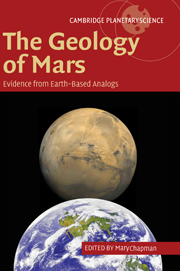Book contents
- Frontmatter
- Contents
- Preface: the rationale for planetary analog studies
- List of contributors
- 1 The geology of Mars: new insights and outstanding questions
- 2 Impact structures on Earth and Mars
- 3 Terrestrial analogs to the calderas of the Tharsis volcanoes on Mars
- 4 Volcanic features of New Mexico analogous to volcanic features on Mars
- 5 Comparison of flood lavas on Earth and Mars
- 6 Rootless volcanic cones in Iceland and on Mars
- 7 Mars interior layered deposits and terrestrial sub-ice volcanoes compared: observations and interpretations of similar geomorphic characteristics
- 8 Lava—sediment interactions on Mars: evidence and consequences
- 9 Eolian dunes and deposits in the western United States as analogs to wind-related features on Mars
- 10 Debris flows in Greenland and on Mars
- 11 Siberian rivers and Martian outflow channels: an analogy
- 12 Formation of valleys and cataclysmic flood channels on Earth and Mars
- 13 Playa environments on Earth: possible analogs for Mars
- 14 Signatures of habitats and life in Earth's high-altitude lakes: clues to Noachian aqueous environments on Mars
- 15 The Canyonlands model for planetary grabens: revised physical basis and implications
- 16 Geochemical analogs and Martian meteorites
- 17 Integrated analog mission design for planetary exploration with humans and robots
- Index
- Plate section
- References
8 - Lava—sediment interactions on Mars: evidence and consequences
Published online by Cambridge University Press: 18 September 2009
- Frontmatter
- Contents
- Preface: the rationale for planetary analog studies
- List of contributors
- 1 The geology of Mars: new insights and outstanding questions
- 2 Impact structures on Earth and Mars
- 3 Terrestrial analogs to the calderas of the Tharsis volcanoes on Mars
- 4 Volcanic features of New Mexico analogous to volcanic features on Mars
- 5 Comparison of flood lavas on Earth and Mars
- 6 Rootless volcanic cones in Iceland and on Mars
- 7 Mars interior layered deposits and terrestrial sub-ice volcanoes compared: observations and interpretations of similar geomorphic characteristics
- 8 Lava—sediment interactions on Mars: evidence and consequences
- 9 Eolian dunes and deposits in the western United States as analogs to wind-related features on Mars
- 10 Debris flows in Greenland and on Mars
- 11 Siberian rivers and Martian outflow channels: an analogy
- 12 Formation of valleys and cataclysmic flood channels on Earth and Mars
- 13 Playa environments on Earth: possible analogs for Mars
- 14 Signatures of habitats and life in Earth's high-altitude lakes: clues to Noachian aqueous environments on Mars
- 15 The Canyonlands model for planetary grabens: revised physical basis and implications
- 16 Geochemical analogs and Martian meteorites
- 17 Integrated analog mission design for planetary exploration with humans and robots
- Index
- Plate section
- References
Summary
Introduction
Solidified lava flow morphologies are a consequence of complex interactions between the moving, cooling lava and its environment. Because no active Martian lava flow has been observed, eruption and emplacement parameters must be determined from the resulting volcanic morphologies. Griffiths and Fink (1992a, b) demonstrated the effects that ambient conditions exert on the gross morphology of lava flows with Newtonian rheologies. Through the use of analog experiments, they concluded that typical lava flow morphologies are created by a balance between the rate at which heat is advected within the flow and the cooling rate – a ratio they quantified with the dimensionless parameter Ψ (Fink and Griffiths, 1990). Gregg and Fink (2000) examined the effect of underlying slope on lava flow morphologies, and concluded that increasing slope has a similar effect to increasing effusion rate. However, Gregg and Smith (2003) show that this relationship breaks down somewhat on slopes steeper than about 20°. Griffiths and Fink (1997) and Fink and Griffiths (1998) examined the effect of ambient conditions on laboratory flows with a Bingham rheology, and observed a similar dependence of morphology with Ψ.
Thus, the main parameters that appear to control lava flow morphologies for lavas with Newtonian or Bingham rheologies are effusion rate, eruption temperature, lava viscosity, underlying slope, and ambient conditions (e.g., Fink and Griffiths, 1990, 1998; Gregg and Fink, 2000).
- Type
- Chapter
- Information
- The Geology of MarsEvidence from Earth-Based Analogs, pp. 211 - 231Publisher: Cambridge University PressPrint publication year: 2007



